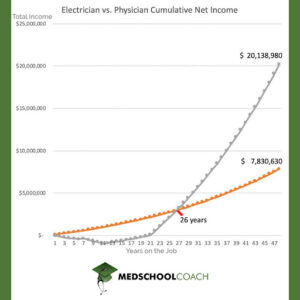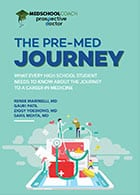
Table of Contents
Fully licensed doctors make an average of $363,000/year, and specialists make more than primary care physicians. Doctor salaries vary greatly based on specialty, location, years of experience, and (unfortunately) race and gender.
An important note: Don’t trust stats from major salary and job sites to guesstimate what you will make after completing residency. The average resident salary is around $63,800 annually, as these doctors are still in training and not yet fully independent physicians. This much lower salary average skews the numbers from sites that don’t differentiate.
The high cost of becoming a doctor must be considered against the many years it will take to earn a significant salary.
We caution pre-meds against making a life decision based on money alone. Still, it’s good to start planning your future finances after taking on medical school expenses and setting healthy expectations regarding salary.
While physician pay increased slightly in 2023, when you adjust for inflation, compensation for doctors has actually decreased significantly in recent years.
In this article, we take you through everything you need to know about a doctor’s salary, major factors that increase or decrease pay, and a few considerations besides money before you jump into med school or a certain residency specialty.
Still not sure which specialty you want to commit to? We offer free resources for you to figure out your best future!
Average Salary
The average doctor’s salary is $363,000/year, with primary care physicians earning around $277,000 and specialists making roughly $394,000. These figures apply to attending physicians, not residents.
There are no official numbers differentiating the salaries of doctors with an MD vs. a DO, but most DO physicians work in primary care, meaning their average annual salary would fall more in that range (unless they specialize).
U.S. doctors tend to make more on average than their counterparts in other areas of the world.
These figures are averages that do not reflect experience level or a doctor’s location, both of which can massively change actual salary payouts. Specialists typically earn more than generalists, and MD physicians are more likely to specialize. Also, higher cost-of-living locations yield higher salaries.
How much does a doctor make per hour? According to national averages, doctors earn anywhere from $50-$200 per hour if you break their salaries down in that way. However, doctors are almost never paid by the hour in the U.S., partly based on the way they work and services they provide.
Salary by Speciality (Compensation Table)
Below is a handy list of average physician salaries in 2025, listed alphabetically. Note: Many surgeries are the highest-paid doctor specialties, while pediatrics and primary care physicians tend to be the lowest-paid specialties.
Related Reading: Least Stressful Specialties
| Specialty | Average Annual Physician Compensation |
| Allergy & Immunology | $322,955 |
| Anesthesiology | $494,522 |
| Cardiology | $565,485 |
| Dermatology | $493,659 |
| Diabetes & Endocrinology | $291,481 |
| Emergency Medicine | $398,990 |
| Family Medicine | $300,813 |
| Gastroenterology | $514,208 |
| Internal Medicine | $312,526 |
| Infectious Diseases | $314,626 |
| Nephrology | $365,323 |
| Neurology | $348,365 |
| Neurosurgery | $763,908 |
| OB/GYN | $382,791 |
| Oncology | $479,754 |
| Ophthalmology | $468,581 |
| Orthopedic Surgery | $654,815 |
| Otolaryngology (ENT) | $502,543 |
| Pathology | $360,315 |
| Pediatrics | $259,579 |
| Physical Medicine & Rehabilitation | $376,925 |
| Plastic Surgery | $619,812 |
| Psychiatry | $332,976 |
| Public Health & Preventive Medicine | $282,011 |
| Pulmonary Medicine | $410,905 |
| Radiology | $531,983 |
| Rheumatology | $305,502 |
| Surgery, General | $464,071 |
| Thoracic Surgery | $720,634 |
| Urology | $529,140 |
These average annual income figures were pulled from Doximity’s most recent income report (2024).
Intraspecialty Variations in Physician Salaries
“Intra-specialty salary range variations” refers to the differences in salaries between doctors within the same specialization.
Variations in pay between same-specialty doctors vary widely from 10th percentile earners to 90th percentile earners. Surprisingly, the income differences within any given specialty tend to be greater than the income differences from one specialty to another.
One reason intra-specialty incomes can vary is due to sub-specialties. For example, on average, a non-invasive cardiologist makes $539,000 a year, while an electrophysiologist earns $672,000 a year.
Another reason for this disparity may be years of experience. For example, some sources report that entry-level dermatologists make around $300,000, while experienced dermatologists may make over $500,000 — possibly over $1 million in top percentile cases.
Location Matters
The cost of living in your location impacts how much you make, as well as how much you have to spend. Urban areas like LA and NYC are more expensive to live in than rural or suburban areas, but urban centers also tend to offer higher salaries.
Below, we detail which cities doctors make the most and the least.
U.S. Cities Where Doctors Make The Most
Here are the U.S. metro areas with the highest average physician compensation, according to Doximity’s Physician Compensation Report:
- San Jose, California — $474,977
- Los Angeles, California — $448,121
- St. Louis, Missouri — $442,576
- Sacramento, California — $440,004
- Minneapolis, Minnesota — $438,756
- San Francisco, California — $437,628
- Phoenix, Arizona — $436,837
- San Diego, California — $430,187
- Charlotte, North Carolina — $429,566
- Las Vegas, Nevada — $426,727
Adjusted for a city’s cost of living, the list changes. Notice California goes from 50% of the list to 0%. Here are the best cities with the highest physician salaries, adjusted for cost of living:
- St. Louis, Missouri
- Louisville, Kentucky
- Oklahoma City, Oklahoma
- Memphis, Tennessee
- Charlotte, North Carolina
- Las Vegas, Nevada
- Indianapolis, Indiana
- Milwaukee, Wisconsin
- Jacksonville, Florida
- New Orleans, Louisiana
U.S. Cities Where Doctors Make The Least
Below are the rankings for the metro areas with the lowest compensation:
- San Antonio, Texas — $371,073
- Denver, Colorado — $371,215
- Washington, D.C. — $371,495
- Boston, Massachusetts — $378,273
- Nashville, Tennessee — $380,533
- Baltimore, Maryland — $382,837
- Philadelphia, Pennsylvania — $387,254
- Providence, Rhode Island — $390,096
- Virginia Beach, Virginia — $390,604
- Birmingham, Alabama — $391,290
But living on the coasts (and Denver) is expensive. Here is the list of cities by lowest physician salary, adjusted for cost of living:
- Washington, D.C.
- Boston, Massachusetts
- Denver, Colorado
- Seattle, Washington
- New York, New York
- Portland, Oregon
- San Francisco, California
- Baltimore, Maryland
- Providence, Rhode Island
- San Diego, California
The Gender Pay Gap in Medicine
The latest Doximity report revealed a slight decrease in the gender pay gap for physicians. Women earn an average of 17%-26% less than their male counterparts — $2 million less over their career lifetime than men.
The Medscape Physician Compensation Report has shown that the specialties with the most significant gender pay gaps include:
- Otolaryngology
- Allergy and Immunology
- Orthopedic Surgery
- Urology
- Ophthalmology
Specialties with the least gender wage inequality include:
- Nuclear Medicine
- Pediatrics
- Hematology
- Colorectal Surgery
- Emergency Medicine
AAMC Faculty Salary Survey confirms that the gender wage gap is the main factor in wage disparities, but also sheds light on race and ethnicity salary gaps in medicine. White men had a higher median salary than men of other races and ethnicities.
A 2024 study found that Asian men, Asian women, Black women, and white women are more likely to enter academic medicine but less likely to be promoted than white men.
Other Factors That Impact Earnings
Below are the significant factors that affect physician salary:
- Ownership: When you’re a partner in your practice, your physician income can be much higher. But the tradeoff is all the risks and costs of running your own business.
- Performance: This may be very obvious, but how well you do your job impacts your income potential, just like any career. Better patient outcomes, more satisfactory reviews, and fewer malpractice cases equate to higher income.
- Inflation: Doctors are not immune to rising costs. Patients, governments, and employers race to make cuts. About 44% of physicians pursue a side gig, putting a strain on our healthcare workers and accelerating burnout.
- School Debt: This factor is another tradeoff. You may spend more on a high-quality medical school or pre-med degree. However, success at prestigious institutions may also increase your likelihood of landing a high-end entry-level doctor’s salary.
- Reimbursements: In recent years, Medicare, Medicaid, and the Affordable Care Act have not adjusted their reimbursements for inflation or other factors. Unless a doctor sees more patients or spends less time with each one, this lack of adjustment typically leads to a pay decrease. Explore the Physician Fee Schedules on the CMS Services website.
- Location: As discussed above, the cost of living in your local area determines each provider’s salary and patient fees. A place with a lower cost of living means a lower wage and a lower cost of eating, transportation, and real estate; so it may be worth the pay cut you see on paper.
- Specialty: As you can see from earlier in this article, your chosen specialty significantly impacts your future income potential.
- Years of experience: As mentioned earlier, how long you have worked in a specialty impacts your salary. The longer you practice and develop clients and your reputation, the higher your salary will be.
Read Next: Is a 3-Year Medical School Right for You?
6 Reasons Why Money Isn’t Everything
While salary is an essential factor, there are other considerations as you make your medical journey toward becoming a physician. Doctors need a work-life balance, too.
Below are key aspects to consider when selecting a specialty that will impact your work-life balance, from when your career starts as an intern to your life as an attending physician.
Medical Training Requirements
Specific residencies, such as pediatrics (a lower-salary specialty), only require a three-year residency. Other specialties, such as neurosurgery (a top-paying specialty), require a seven-year training program.
During residency, you’ll work long hours and days, committing many of your prime years to medical education on a resident’s salary (which is significantly less than a practicing physician’s salary). Consider the costs and benefits of longer or shorter residencies.
Competitiveness of Medical Specialties
Fill ratios are used to determine the number of applicants per position available. The closer that ratio is to 1, the closer there is to 1 spot for every applicant. The further you deviate upwards from that number, the harder it is to land a spot.
Take interventional radiology as an example. There are 1.86 applicants for every 1 position available, and only 136 openings are available per year. In contrast, anesthesiology has 1.09 applicants for each position open and 1,804 openings per year.
Do you have the grades, experience, and MCAT score to be a competitive applicant? Find out your odds of getting into your preferred medical school with our Free Medical School Chance Predictor.
Your Patience for Patients
Most physicians practice some form of clinical medicine. A lot of that time is spent seeing and charting patients. You often think about patient cases after you leave work, impacting your work-life balance.
There is also the consideration of being “on-call.” A specialty like dermatology is largely outpatient-based without much on-call activity. However, specialties like cardiology may be tied to the hospital and demand regular “on-call” hours. Consider whether you want to think about patients and always wear a pager.
The Job Site
Medical practice environments differ. There are excellent, cozy office settings in rural clinics and busy hospitals in major medical centers.
Medical doctors working in critical care units, endocrinology, internal medicine, oncology, or infectious diseases will often be in a higher-stress position. Medical doctors who work in private practice, psychiatry, or orthopedics will usually feel less stressed.
Ask yourself: Would you rather work full-time in a high-stress operating room or a quiet exam room?
Academic Interest
Solid academic pursuits in research will impact the number of publications, presentations, conferences, and research you do throughout your career. Do you want a career in academic medicine or healthcare research, instead of other less academia-centric specialties?
Figure out if academic or research work excites you as much as patient work.
Keep Your Finances in Check
Many applicants have undergraduate debt and medical school debt. They may be deferring that debt while they’re still studying. The salaries you earn in residency generally range between $50,000-$75,000. (Average resident salary is around $64,000.)
Residency takes a lot of years to make a relatively small amount of money (for a physician) while simultaneously having so much debt to pay back. However, specialties with longer residencies tend to also be the highest-paying once you’re an attending physician. Think about whether you’d rather defer your earnings to pursue a high-paying specialty or whether you’d rather make a reasonable income sooner by choosing a shorter residency.
FAQs
A physician's salary is generally significantly higher than that of Physician Assistants (PAs) and Nurse Practitioners (NPs). While PAs and NPs can make over $100,000, the average physician makes over $300,000.
Doctors earn significantly more than engineers and other advanced-degree professionals due to a number of factors:
- Length and cost of education (pre-med, med school, residency, fellowship)
- Delayed salary (negligible or lower earnings until after residency or fellowship)
- High demand for medical services (especially as health demands and spending continue to rise)
Although some engineers in the highest-paying specialties (like tech) may make more than doctors in low-paying specialties (like pediatrics), doctors simply earn more on average because of greater education costs, later salary earning potential, and much higher demand for medical services.
Yes, although becoming a doctor is expensive and lengthy, over the course of your career, working as a doctor is significantly more lucrative than a blue-collar job.
We built out a chart showing how much doctors earn over their career versus a respectable “traditional” trades job — say, an electrician. The break-even on net income between the two positions is 26 years! Yet, a doctor can expect to make $12 million more over their whole career.
Note: This chart assumes that a pre-med will have spent $75k+ per year for 4 years of undergrad school, $50k a year for 2 gap years, $75k+ a year for 4 years of medical school, and then earned $50k+ for a gap year, and somewhere south of $100k per year for up to 7 years as a resident. Only then do individuals start earning like an attending. Inflation and annual wage increases are incorporated into these metrics.
After all these considerations, 78% of physicians still state that they would choose medicine again if they had to restart their career from the beginning as pre-medical students.
Your Path to Medicine Starts Here
Becoming a doctor requires a lot of time, effort, money, and dedication to the career. However, it is a rewarding career path not only because of the base salary but also because your job all day is helping others.
If you’re applying to medical school, schedule a free consultation with us to learn more about working with an expert Physician Advisor to enhance your application.

Sahil Mehta MD
Dr. Mehta is the founder of MedSchoolCoach and has guided thousands of successful medical school applicants. He is also a practicing physician in Boston where he specializes in vascular and interventional radiology.






